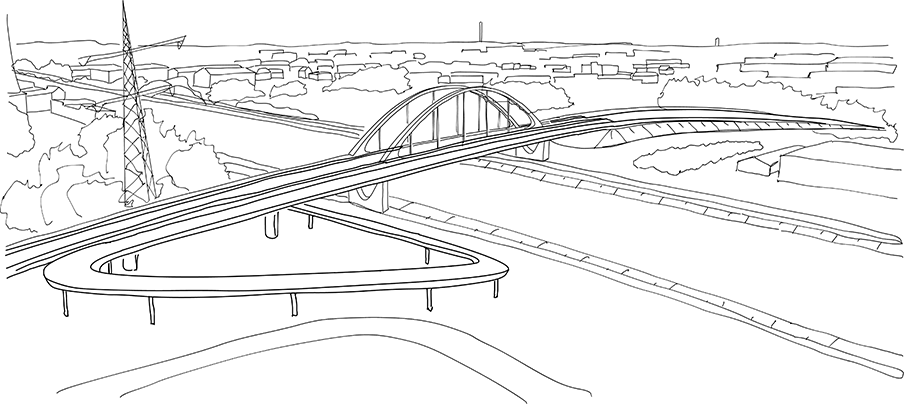Drie Fonteinen Bridge
With the new Drie Fonteinen Bridge, the Flemish Sint-Pieters-Leeuw gained a striking landmark; a bridge that is to become the catalyst for economic growth and accessibility of the region. The Drie Fonteinenbrug, located south of Brussels, is in fact made up of two bridges; one bridge of 180 metres for freight traffic and one bridge of 325 metres for cyclists. The bridge has a main span of 80 metres across the canal to Charleroi. Royal HaskoningDHV was responsible for the architectural design of the bridge, which was realised in collaboration with Sweco Belgium, and was commissioned by De Vlaamse Waterweg.

Lucas van der Wee
0Main span
02 lanes motorway
0Bicycle bridge

In August 2018, the start signal was given in Sint-Pieters-Leeuw for the construction of this new bridge that alleviates traffic pressure in the region and ensures better accessibility and traffic safety in and around Sint-Pieters-Leeuw. The new Drie Fonteinen Bridge gives freight traffic an alternative route via the ring road around Brussels and via the right bank of the canal. At the same time, the combination with a separate two-way cycle path ensures a good connection to the new bicycle freeway and other bicycle paths. This creates a comfortable and safe cycling route.

Waterborne transport by inland shipping will also receive a strong boost as the canal to Charleroi will be further developed as a main waterway. The Drie Fonteinenbrug will enable the construction of new quays and the development of a regional transshipment centre on the left bank of the canal. This will provide more opportunities to transport goods over the water. The new bridge will also facilitate shipping by providing a free passage height of up to 7.20 metres, so that the bridge does not have to be opened for ships who want to pass.






The design is characterized by its streamlined simplicity and clear visual language, according to the principles of the 'Ligne Claire", a style that has its origins in the Belgium of Tintin creator Hergé. The two freestanding arches literally form the climax of the bridge and are clearly visible to the millions of travellers who pass the Brussels ring road every year in a southward direction. A subtle choice is the configuration of the hangers under both arches. They have a common virtual vanishing point 80 metres above the middle of the bridge. This geometric principle ensures that the hangers never cross each other optically. An additional consequence of this configuration is that the optimal pressure line of the arch is influenced by it; the arch becomes more tapered than the more common parabolic arches which have vertical cables. The arcs become more slender upwards as the pressure in the arc decreases. The birth of the arches, on the other hand, is broadly set to provide lateral stability to compensate for the absence of cross-links between the arches.

Lucas van der Wee
The eastern approach span is also special because of the choice of three sets of V-shaped pillars. This configuration was chosen to limit the number of foundations due to the many cables and pipes in the underground. Thanks to the V-shape, six relatively small fields can be created on the level of the road deck. As a result, the concrete bridge can be constructed with the same slenderness as the deck of the steel arch bridge and relatively cheap prefabricated beams could be chosen.

Lucas van der Wee
The loop for the bicycle bridge is also simple in design. The 235 metre long ramp is divided into equal spans of 16 metres, fitted with a central steel torsion beam with steel crossbars. The last span towards the arch is larger and is supported by the forked steel stair stringer, a choice that has to do with the underground presence of a large cooling water pipe. The bicycle bridge is finished with an elegant handrail of steel bars.
Project facts
- ClientDe Vlaamse Waterweg
- LocationSint-Pieters-Leeuw, Brussels, Belgium
- Date2017 - 2018
- ChallengeRoyal HaskoningDHV was responsible for the architectural design of the bridge.
- SolutionArch bridge across the canal Brussel-Charleroi, 80 metres main span, 180 metres 2 lanes motorway, 325 metres bicycle bridge.
Infrastructureenquiries
Contact our Infra experts